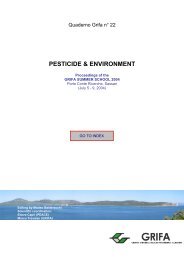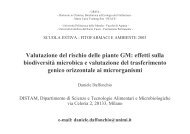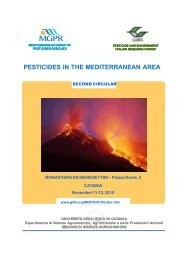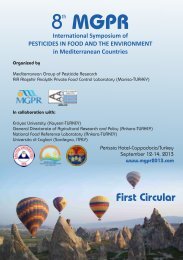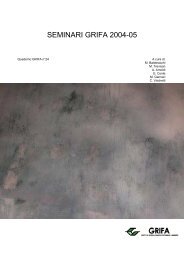International Congress BIOLOGICAL PRODUCTS - Gruppo di ...
International Congress BIOLOGICAL PRODUCTS - Gruppo di ...
International Congress BIOLOGICAL PRODUCTS - Gruppo di ...
Create successful ePaper yourself
Turn your PDF publications into a flip-book with our unique Google optimized e-Paper software.
9<br />
IMPROVEMENT OF SOIL PROPERTIES AND PHYTOPARASITIC NEMATODES SUPPRESSION BY<br />
COMPOSTED OLIVE MILL WASTE<br />
Convertini Grazia (1) , Ferri Donato (1) , Sasanelli Nicola (2) , D’Addabbo Trifone (2)<br />
(1) Istituto Sperimentale Agronomico (MIPAF) – Via Celso Ulpiani, 5 - 70125 Bari, Italy. E-mail:<br />
donatoferri.isaba@tuttopmi.it<br />
(2) Istituto per la Protezione delle Piante - Sez. <strong>di</strong> Bari - C.N.R. - Via Amendola 165/A, 70126 Bari, Italy. E -mail:<br />
nemans13@area.ba.cnr.it<br />
Summary.<br />
The effect of composted olive mill wastes (composted - OMW) soil amendments on phytoparasitic nematodes and on<br />
soil fertility was investigated in a sandy soil heavely infested by Meloidogyne incognita in southern Italy (Apulia<br />
region). Composted olive pomace obtained by mixing fresh solid cake coming from the three-phase decanter (for olive<br />
oil production) with farmyard manure (10, 20 and 40 t ha -1 ), another compost obtained by mixing exhausted solid<br />
cake (chemical extraction of residue olive oil) with wheat straw and poultry manure (10, 20 and 40 t ha -1 ) and raw<br />
sewage supplied at 40 and 80 m 3 ha -1 , were compared with two controls : i) untreated soil; ii) treatment with<br />
fenamiphos (tra<strong>di</strong>tional nematicide) at 0.3 t ha -1 . Tomato crop yield, soil nematode population and root gall index were<br />
recorded in all the plots. Soil fertility parameters, as total N, nitrates, ammonium, total, extracted and humified organic<br />
C, NaHCO3-P, exchangeable bases, heavy metals were determined for the most significant rate of each amendment.<br />
Crop yield was enhanced in all amended plots and pomace based composts were also suppressive on M. incognita.<br />
Moreover, compost amendments increased soil organic matter content, improved N availability and protected soil<br />
organic fractions from the fast decomposition occurring in the semi-arid con<strong>di</strong>tions of southern Italy.<br />
Keywords: Control, Meloidogyne incognita, nematodes, olive mill wastes, soil fertility.<br />
INTRODUCTION<br />
The <strong>di</strong>sposal of olive mill wastes (OMW), fresh pomace and raw sewage, represents a serious environmental<br />
problem in the areas of cultivation of olive, as large amounts of these materials are produced in a short period every<br />
year (Ranalli and De Mattia, 1996).<br />
The use of these materials as soil amendment could represent a possible alternative solution to this problem. Recent<br />
stu<strong>di</strong>es showed that in the soil characterized by poor fertility, OMW incorporation into the soil improves some chemical<br />
soil properties at <strong>di</strong>fferent texture in southern Italy (Ferri et al., 2001). Also soil porosity, aggregates stability,<br />
hydrological properties were improved by the application of OMW (Pagliai, 1996), although contrasting results derived<br />
from previous experiments (Bonari and Ceccarini, 1993 ).<br />
Moreover, a suppressive action on soil phytoparasitic nematodes has been also reported among the effects of olive<br />
mill wastes incorporation into the soil (Rodriguez-Kabana et al., 1995; D’Addabbo and Sasanelli, 1996, Sasanelli et al.,<br />
2002).<br />
Objective of the field experiment described in this paper was a comparative evaluation of the effect of fresh and<br />
exhausted composted olive pomace and raw sewage application on a population of the root-knot nematode<br />
Meloidogyne incognita and on the chemical properties of the soil.<br />
MATERIAL AND METHODS<br />
A sandy soil at Monteroni (province of Lecce, southern Italy), heavily infested by Meloidogyne incognita (Kofoid<br />
et White) Chitw. (Pi = 9 eggs and juveniles/cm 3 soil), was sub<strong>di</strong>vided in 12 m 2 plots, spaced 1 m each other, accor<strong>di</strong>ng<br />
to a randomized block design with four replicates for each treatment. Composted olive pomace obtained by ad<strong>di</strong>ng<br />
fresh solid cake (93%) from a three-phase decanter (for olive oil production) with farmyard manure (7 %) and a<br />
compost obtained by mixing exhausted pomace solid cake (91%) (after the chemical extraction of residue olive oil) with<br />
wheat straw (2%) and poultry manure (7 %) were <strong>di</strong>stributed on the plot surface at 10, 20 and 40 t ha -1 rates and then<br />
incorporated into the soil at 25 – 30 cm depth by rotavation. Raw sewage was added at the dosages of 40 and 80 m 3 ha -1 .<br />
Untreated soil and 300 kg ha -1 fenamiphos applied before transplanting were used as controls. One month old seedlings<br />
of tomato (Lycopersicum esculentum L.), cv. Ton<strong>di</strong>no <strong>di</strong> Zagaria, were transplanted into the plots three months after the<br />
treatments. During the growing season the field received the usual cultural practices.<br />
At the end of the crop cycle in each plot the tomato yield was recorded, the nematode gall infestation index on the<br />
roots was estimated on a 0 – 5 scale (0 for not galled roots and 5 for roots completely deformed by many large galls)<br />
(Di Vito et al., 1979) and the nematode population density was determined in the soil (Coolen, 1979).<br />
PDF creato con FinePrint pdfFactory versione <strong>di</strong>mostrativa http://www.secom.re.it/fineprint<br />
65



